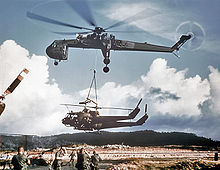Sikorsky CH-54 Tarhe
| CH-54 Tarhe | |
|---|---|

| |
| A CH-54A carrying a "Daisy Cutter" parachute bomb | |
| Role | Heavy-lift cargo helicopter |
| Manufacturer | Sikorsky Aircraft |
| First flight | 9 May 1962 |
| Retired | US Army 1970s, National Guard 1980s |
| Status | retired |
| Primary user | United States Army |
| Number built | 105 |
| Variants | S-64 Skycrane |
The Sikorsky CH-54 Tarhe is an American twin-engine heavy-lift helicopter designed by Sikorsky Aircraft for the United States Army. It is named after Tarhe, an 18th-century chief of the Wyandot Indian tribe whose nickname was "The Crane".[1] The civil version is the S-64 Skycrane.
Development


Initial work on the Sikorsky "sky-crane" helicopters began in 1958 with the piston-engined Sikorsky S-60. The first flight of the turboshaft-powered S-64 Skycrane was on 9 May 1962.[2]
The United States Army eventually purchased 105, designating them CH-54. Used in Vietnam for transport and downed-aircraft retrieval, it was highly successful. As of 2014[update], it holds the helicopter record for highest altitude in level flight at 11,000 m (36,000 ft), set in 1971[3] and fastest climb to 3,000[4] 6,000,[5] and 9,000[6] m (10,000, 20,000, and 30,000 ft).
The Skycrane can hold its cargo up and tight against its center spine to lessen drag and eliminate the pendulum effect when flying forward, as well as winch vehicles up and down from a hovering position, so the helicopter can deploy loads while hovering. Due to budget cuts, the Heavy Lift Helicopter (HLH) program was canceled and the CH-54s not upgraded with larger engines. The Boeing CH-47 Chinook gradually supplemented it in combat and eventually replaced it in Regular Army aviation units, although CH-54 Skycranes remained in Army National Guard service until 1991.
Today, Erickson Air-Crane of Central Point, Oregon, operates the largest fleet of S-64 helicopters in the world under the name Erickson S-64 Aircrane. These can be equipped with water-dropping equipment (some also have foam/gel capability) for firefighting duties worldwide. After obtaining the type certificate and manufacturing rights in 1992, Erickson remains the manufacturer.
Variants

- YCH-54A
- Preproduction aircraft, six built.[7]
- CH-54A
- Production model powered by two 4,500 shp (3,400 kW) Pratt & Whitney T73-P-1 turboshafts, 54 built.[7]
- CH-54B
- Heavier version of the CH-54A with two 4,800 shp (3,600 kW) T-73-P-700 turboshafts and twin-wheeled main undercarriage, 37 ordered, 29 built.[8]
- S-64B
- In 1968 Sikorsky proposed a three-engined growth version with upgraded rotor and gearbox. This was not proceeded with but did form the basis for the CH-53E Super Stallion.[9]
Operators
Surviving aircraft
A large number of surviving airframes exist in flyable condition as well as in museum collections worldwide.
Specifications (CH-54B)

General characteristics
- Crew: 3
- Capacity: 20,000 lb (9,072 kg) payload
- Length: 88 ft 6 in (26.97 m)
- Height: 25 ft 5 in (7.75 m)
- Empty weight: 19,800 lb (8,981 kg)
- Max takeoff weight: 47,000 lb (21,319 kg)
- Powerplant: 2 × Pratt & Whitney T73-P-700 turboshaft engines, 4,800 shp (3,600 kW) each
- Main rotor diameter: 72 ft 0 in (21.95 m)
- Main rotor area: 4,071.5 sq ft (378.25 m2)
- Blade section: - NACA 0011 mod[13]
Performance
- Maximum speed: 130 kn (150 mph, 240 km/h)
- Cruise speed: 100 kn (120 mph, 190 km/h)
- Range: 200 nmi (230 mi, 370 km)
- Rate of climb: 1,330 ft/min (6.8 m/s)
See also
Related development
Aircraft of comparable role, configuration, and era
Related lists
References
- Notes
- ^ Ohio History Central page on Tarhe
- ^ Taylor 1976, p. 386.
- ^ "FAI Record ID #9918 - Altitude in horizontal flight. Class E-1 (Helicopters), turbine Archived 5 January 2015 at the Wayback Machine" Fédération Aéronautique Internationale (FAI) Retrieved: 21 September 2014.
- ^ "FAI Record ID #9942 - Time to climb to a height of 3 000 m. Class E-1 (Helicopters), turbine Archived 23 June 2015 at the Wayback Machine" Fédération Aéronautique Internationale (FAI). Retrieved: 21 September 2014.
- ^ "FAI Record ID #9957 - Time to climb to a height of 6 000 m. Class E-1 (Helicopters), turbine Archived 23 June 2015 at the Wayback Machine". Fédération Aéronautique Internationale (FAI). Retrieved: 21 September 2014.
- ^ "FAI Record ID #9960 - Time to climb to a height of 9 000 m. Class E-1 (Helicopters), turbine Archived 24 June 2015 at the Wayback Machine". Fédération Aéronautique Internationale (FAI). Retrieved: 21 September 2014.
- ^ a b Harding 1990, p.243.
- ^ "Helis.com". CH-54B Tarhe. Retrieved 30 July 2017.
- ^ "S-64 Skycrane (CH-54 Tarhe)". Sikorsky Product History. Retrieved 30 July 2017.
- ^ "What Is a Helicopter?". nasa.gov. Retrieved 26 January 2013.
- ^ "Sikorsky CH – 54B Skycrane Helicopter". nasa.gov. Archived from the original on 16 February 2013. Retrieved 26 January 2013.
- ^ "Sikorsky CH-54 Tarhe Flying crane". www.Military-Today.com. Retrieved 26 January 2013.
- ^ Lednicer, David. "The Incomplete Guide to Airfoil Usage". m-selig.ae.illinois.edu. Retrieved 16 April 2019.
- Bibliography
- Francillon, René J. (Spring 1991). "The Army Guard's Weightlifter". World Air Power Journal. 5: 36–41.
{{cite journal}}: CS1 maint: year (link) - Harding, Stephen (1990). U.S. Army Aircraft since 1947. Shrewsbury, UK: Airlife. ISBN 1-85310-102-8.
- Taylor, John W. R. (1976). Jane's All the World's Aircraft 1976–77. London: Jane's Yearbooks. ISBN 0-354-00538-3.
External links
- CH-54 U.S. Army Aviation history fact sheet
- The short film STAFF FILM REPORT 66-2A (1966) is available for free viewing and download at the Internet Archive.
- The short film STAFF FILM REPORT 66-21A (1966) is available for free viewing and download at the Internet Archive.
- HELIS.com Sikorsky S-64/CH-54 Database
